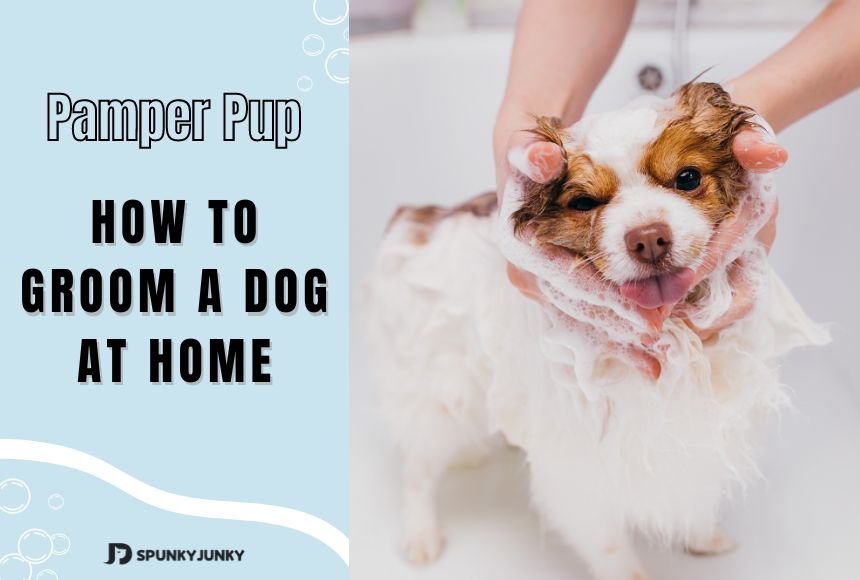Welcome to the world of dog grooming. Are you anxious about expensive pet grooming costs? In fact, you can groom your dog at home, too. A little care can make your furry friend look and feel great.
Grooming your dog at home not only helps keep them healthy but also strengthens your bond.
So, how to groom a dog?
Next, let’s explore some simple and practical dog grooming tips. Effective ways to groom your beloved puppies and make sure they stay clean, cozy, and cute!
How to Groom a Dog at Home
In the following guide, we’ll walk you through 5 ways to groom your dog. Make sure your pup stays clean, comfortable, and irresistibly adorable by understanding basic dog grooming tips and tricks.
How to groom a dog? Let’s start with dog hair!
1. Brushing your dog at Home

Choose the right brush: Choose the right brush for your dog's coat type. For long-haired puppies, use a pin brush. The bristle brush is for short to medium dogs. If your dog has mats or tangles, a smoother brush will help.
Start gently: Start at the dog's head, work your way down, and stroke gently. Be especially careful with sensitive areas like the ears and belly.
Massage and circulation: Brushing isn't just for the fur. It's like giving your furry friend a massage! Brush into the skin to stimulate circulation and loosen dandruff.
Check for unwanted guests: Look for burrs, mats, and anything that might get caught in your dog's fur. This is also a good time to check the skin for cuts or abrasions.
Watch out for dog paws: Please work it out carefully with your fingers or dog paw separator. Don't push too hard, as this could injure your puppy.
Positive Atmosphere: Make grooming a positive experience. Give rewards and praise during and after. That way, your dog will associate grooming with something nice.
Brushing your dog at home is a great way to bond and keep your dog healthy. So grab the right brush, create a cozy space, and enjoy quality time with your dog.
2. Bathing your dog at Home

It's important to bathe your dog regularly, but not too often. The frequency depends on their breed and coat type. Overbathing can strip your dog of natural oils and dry out his coat.
Before bathing the dog, let’s collect supplies first:
● Prepare a mild dog shampoo
● Cotton balls for ears
● Mineral oil for eye protection
●Towels
● Hair dryer
Prepare the above supplies and now start preparing for bathing:
1. Choose a suitable bathing location, such as a bathtub or basin.
2. Place cotton balls in your dog’s ears to prevent water from entering.
3. Put a few drops of mineral oil in your dog’s eyes to protect them from shampoo.
Now, you can start bathing your dog:
1. Wet and Shampoo: Wet your dog's fur with warm water, avoiding the head for now. Apply dog shampoo from the neck down, massaging gently to create a lather.
2. Lather and rinse: Gently scrub your puppy's coat, paying attention to dirty areas. Rinse thoroughly with warm water, making sure no shampoo remains.
3. Dry and shake: Use a towel to bathe and rub your dog after bathing. They may splash, so be prepared for a splash!
4. Blow drying: If your dog is comfortable, use a hair dryer on a low setting. Keep a safe distance and avoid their faces.
5. Final step: When they're mostly dry, groom your dog well. This helps prevent tangles and keeps the coat looking neat.
Remember, bathing your dog can be a bonding experience. Stay calm, use positive words to encourage them, and make it an enjoyable habit. With a little practice, you'll become an expert at keeping your dog fresh and clean!
3. Nail Trimming at Home

If you hear your dog's nails tapping against the floor, they are too long and must be trimmed. Now, you can grab your nail clippers and go for it. This may be a difficult thing, but it may be easier according to the following steps:
Use the right tools: Use specially designed dog nail clippers with safety guards. These guards help prevent nails from being cut too short.
Find the safe zone: Identify the "fast" areas of the blood vessels within the nail. Trim only the hook-shaped part of the nail that curves downward.
Start Small: If your dog isn't used to having their nails trimmed, start slowly. Get them used to being touched from an early age.
Trim gently: Take your time and use gentle movements when trimming your nails.
Oops, it’s bleeding: Accidentally cut? Don't worry. Apply some styptic powder to stop the bleeding. This is a common accident and easy to deal with.
Remember, patience is key when trimming your dog’s nails. With some practice and positive reinforcement, you can master nail trimming and ensure your dog's paws stay healthy and comfortable.
4. Ear Cleaning at Home

Don’t forget the dog ears! A lot of dirt and bacteria can remain in your dog's ears. Cleaning your dog's ears regularly will help keep them clean and healthy. Next, let’s take a look at how to clean dog ears:
Gently wipe the external auditory canal: Focus on cleaning only the outside of your dog’s ears. You can use a damp cloth or a cotton swab soaked in mineral oil.
Do not insert into the ear canal: Remember, never insert anything deep into the ear canal. Attach to the outer area to avoid damaging your dog's sensitive ears.
Hair Care: Some dogs may benefit from plucking the hair inside their ears to promote proper air circulation. Check with your veterinarian to see if this is necessary for your dog.
5. Tooth Brushing at Home

Choose a toothpaste suitable for dogs. Let your dog smell and lick a little toothpaste on your finger and toothbrush. This way you can identify if they like it or not.
Choose a good toothpaste and a suitable toothbrush, and start brushing your dog’s teeth now:
1. Gently brush the surface of your dog’s teeth.
2. Pay attention to cleaning the parts inside the dog’s teeth that are prone to bacteria.
3. Give your dog some snacks or toys as rewards after cleaning to encourage them to keep brushing.
In addition to brushing your dog’s teeth, you can also choose to use chew toys to promote your dog’s dental health. These toys help keep teeth clean by reducing plaque and tartar buildup.
These simple steps can help maintain your dog's oral health, ensuring a bright smile and fresh breath.
What Grooming Dog Tools Do I Need?
● Rubber-bristled brush, wire slicker, steel comb, and/or de-shedding tool
● Nail clippers (specifically for dogs) and/or Dremel grinder
● Styptic pencil (for accidental bleeding)
● Toothbrush and toothpaste (specifically for dogs)
● Cotton balls and/or soft, reusable cloth squares
● Blunt-ended (round tip) shears and/or a small clipper with guide combs
● Shampoo (specifically for dogs) and conditioner (optional, specifically for dogs)
● Microfiber towel
● Hair dryer (optional)
FAQ about How to Groom a Dog
1. How Often Should I Brush and Bathe My Dog?
To keep your dog looking and feeling their best, how often you groom and bathe them depends on their coat type.
If your dog has short or bristly hair, weekly brushing with a rubber bristle brush is all you need to help distribute skin oils and keep the coat smooth.
For long, silky, or curly hair, brush daily with a rubber bristle or wire smooth brush.
Then use a steel comb to help prevent tangles and messy mats.
If your dog has a double coat, lightly grooming with an undercoat rake once a week will do wonders. Long-haired puppies may need professional grooming every 4-8 weeks, while short-haired puppies can be bathed monthly.
2. How often should I trim my dog’s nails?
Keeping your dog's nails at the proper length is critical to preventing discomfort and paw problems. To keep the nails from touching the ground, they must be trimmed every 3-4 weeks.
Final Thoughts
That's all for a guide on how to groom a dog at home like a pro.
Remember, grooming is not only about looks but also about comfort. It's about your dog's overall health.
You're giving your furry companion the love and care he deserves by grooming, bathing, trimming nails, cleaning ears, and even brushing teeth.
With these simple steps and patience, you can keep your pup looking good and create lasting memories with them. Don't wait any longer. Go and try it!






